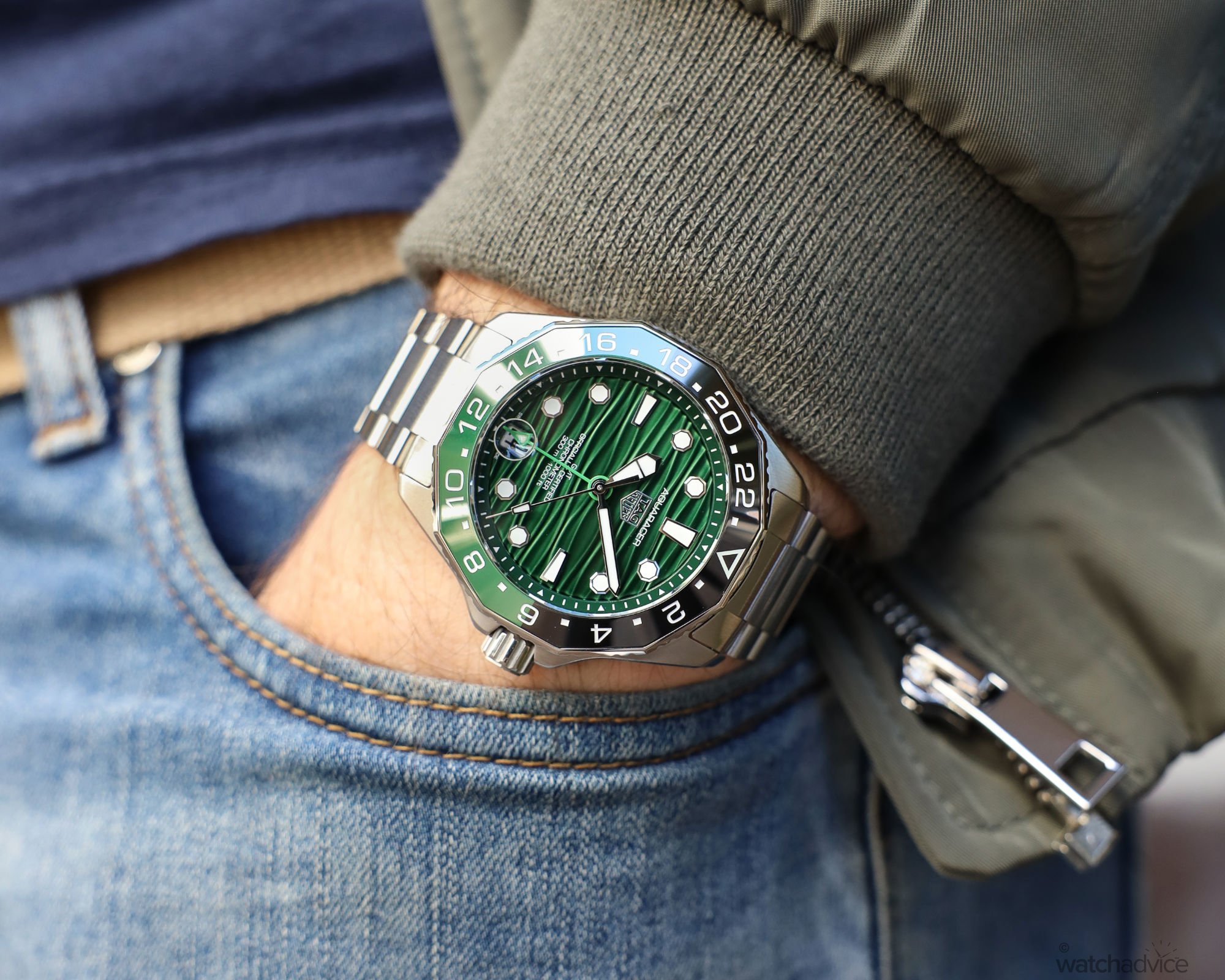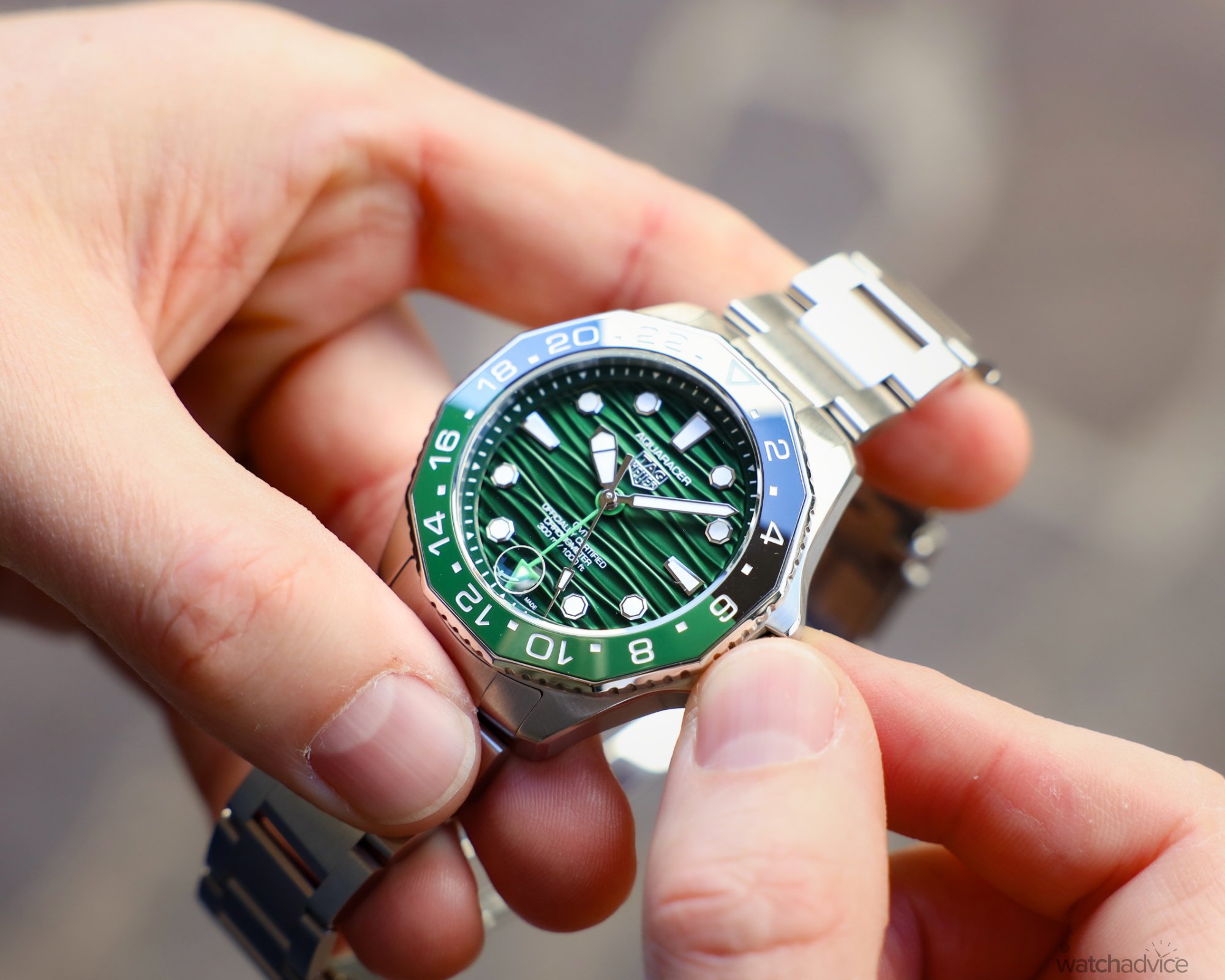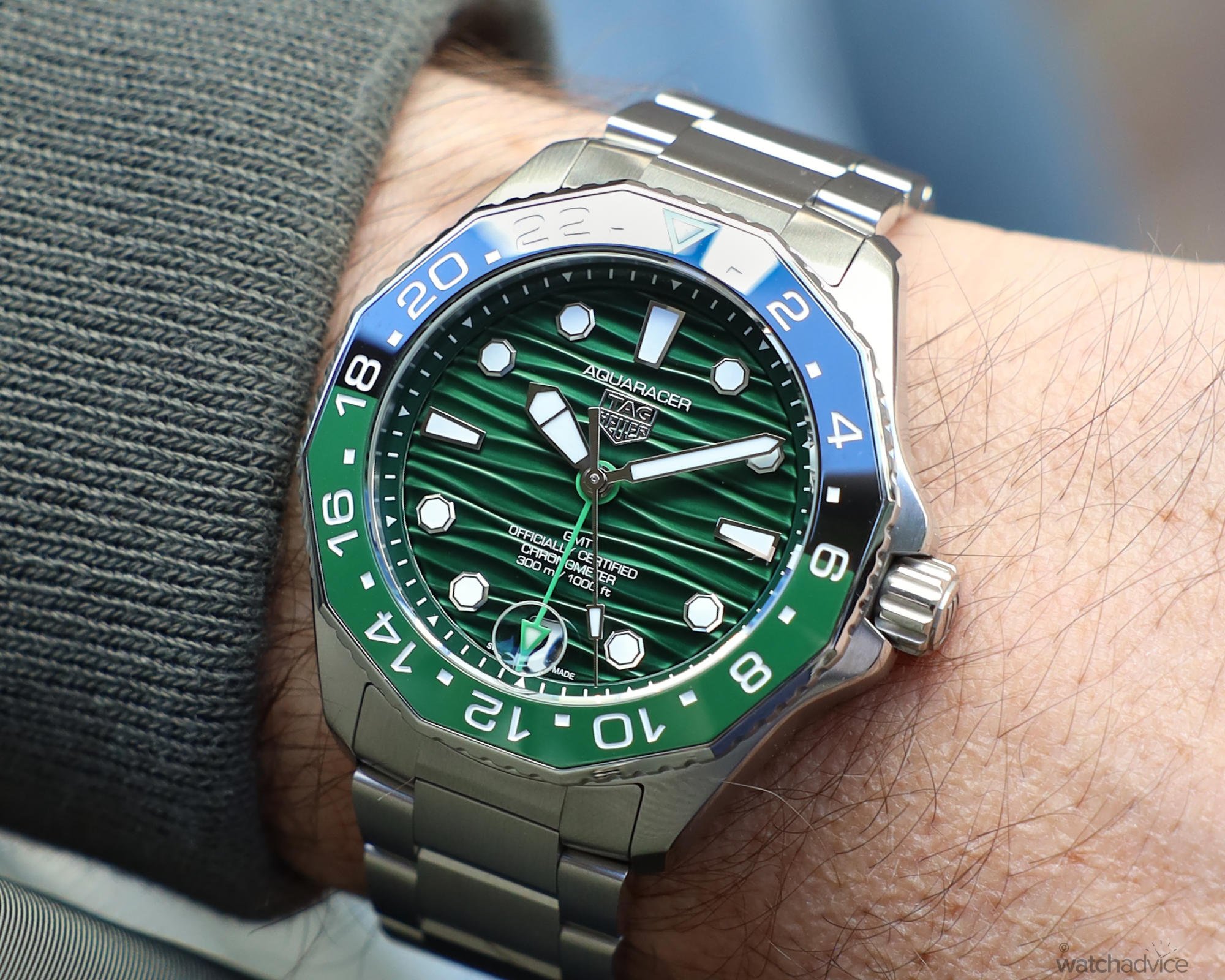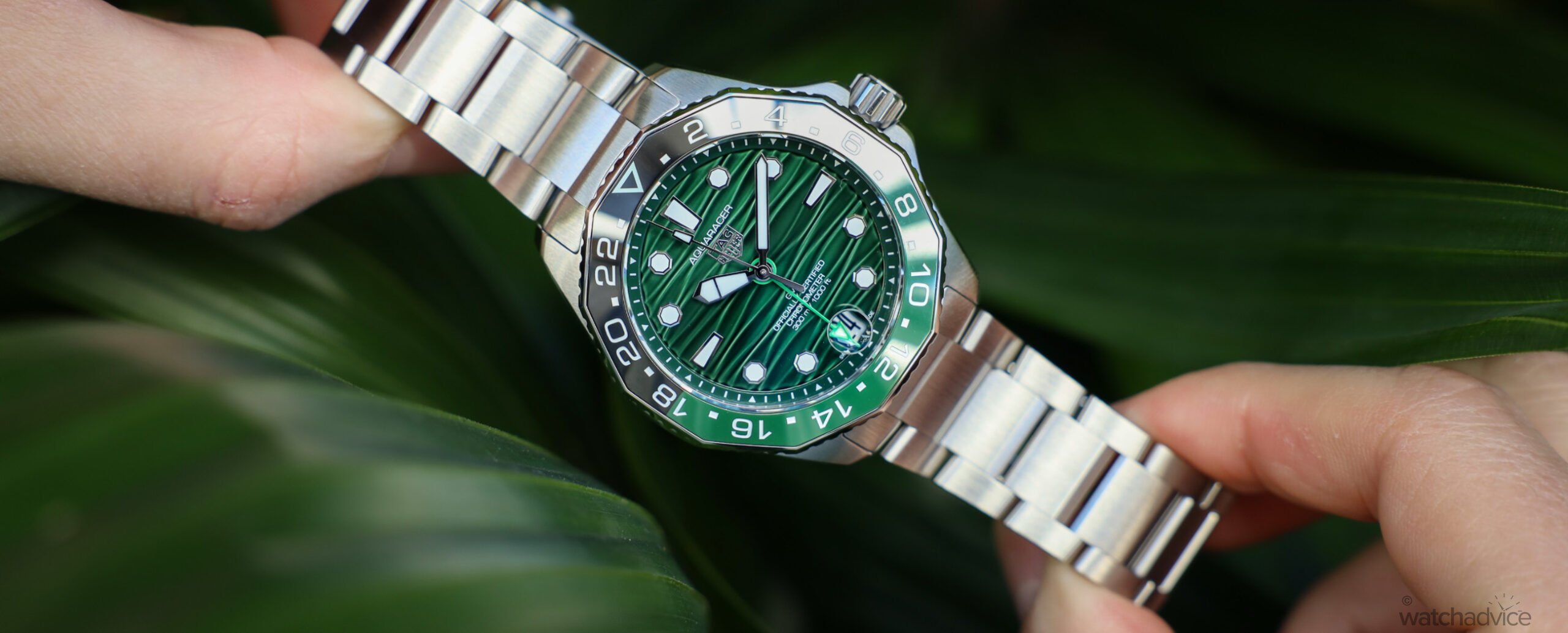TAG Heuer has refined their Aquaracer collection and with many improvements, we wanted to see what all the hype was about. Here’s what we thought…
What We Love:
- Better proportions and size
- On-the-fly micro-adjust
- New colours and dial aesthetics
What We Don’t:
- Being a Caller GMT rather than a Flyer GMT
- Cyclops window over the date aperture
- Some may find the clasp isn’t as sturdy as other pieces on the market
Overall Rating: 8.75/10
- Value for Money: 9/10
- Wearability: 9/10
- Design: 8.5/10
- Build Quality: 8.5/10
TAG Heuer has been on a run of late. At the start of 2023, they brought us a new look Carrera Chronograph “Glassbox” for its 60th anniversary and seemed to knock it out of the park with these. This run continued through 2023 with new variations of the Carrera, but then mid-year, a range of new Monaco’s in titanium with skeleton dials popped up and we saw Max Verstappen sporting a unique version of one of these on his wrist for much of the year. This year, 2024 saw new Carrera variants come out at LVMH Watch Week, including the Dato and a teal green Tourbillon Chronograph and then at Watches & Wonders 2024, the Monaco Split Seconds Chronograph based on TAG Heuer’s Only Watch entry was released to much applause. Oh, and let’s not forget the Formula 1 x Kith collaborations. But, all this left us wondering, what about the Aquaracer? We saw smaller versions of the Aquaracer Northern Lights models at LVMH watch week, which gave us a small taste of what’s to come, so with anticipation, many people were waiting for a potential new facelift for TAG Heuer’s dive watch collection. And they delivered!
First Impressions
Sitting with the people from TAG Heuer for a photo session of the new 2024 novelties at Watches & Wonders this year, we had the opportunity to have a first glance at the new Aquareacer collection – a little bit of a surprise to be honest as both Chamath and I were focused on the mission at hand. But when we did see these, our first thoughts were the same. Wow, nice job TAG Heuer! A more ergonomic case size, re-designed dials with 3D texturing, a movement with COSC certification that was specifically designed by AMT for TAG Heuer and topped off with their on-the-fly micro-adjust in the clasp to get a better fit. The colour combinations were also done so well across the time/date and the GMT models.
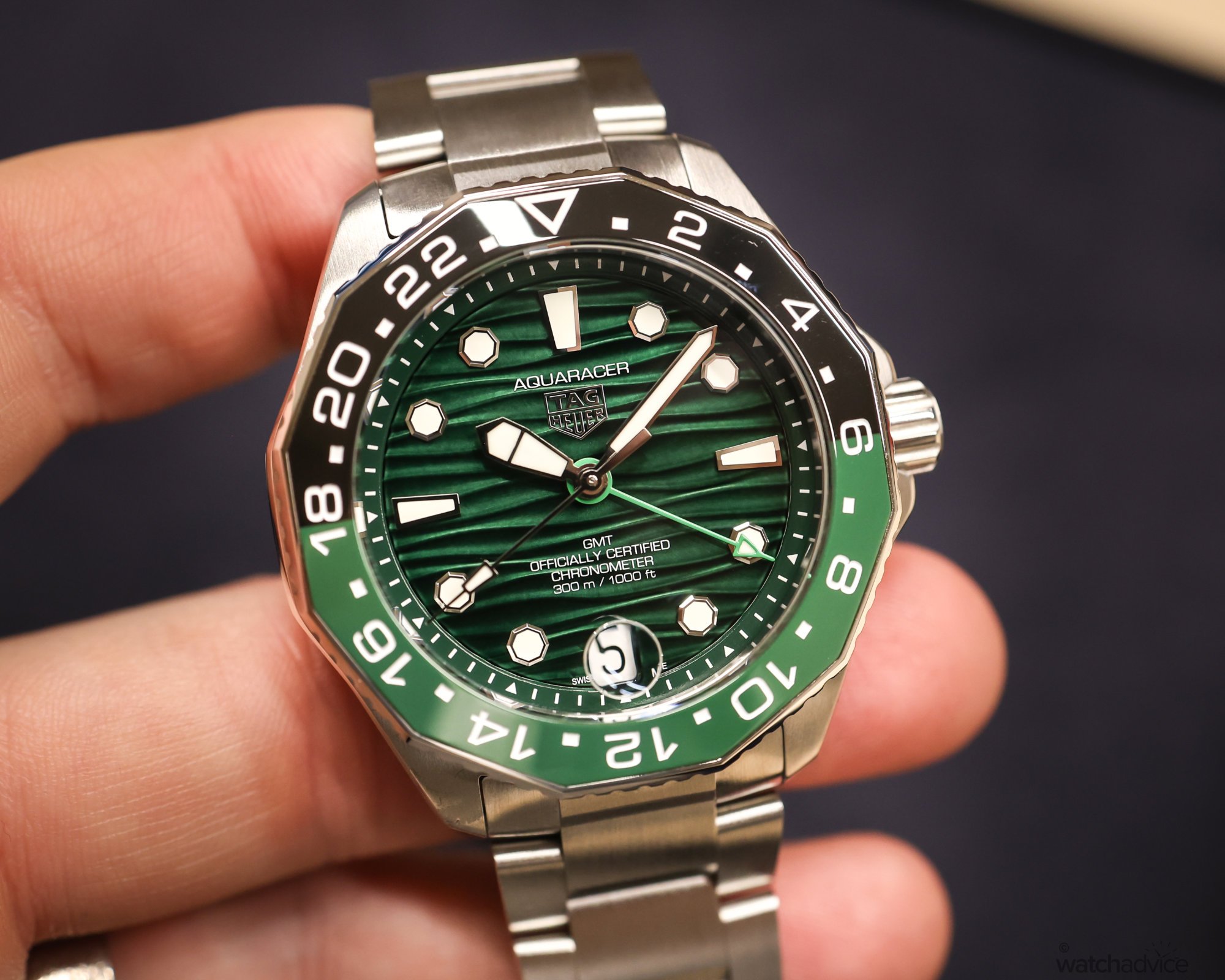
Our first question was, “Can we try them on?” quickly followed by, “Can we get our hands on these for a review?” thankfully the answer to both questions was “yes”. When we had the collection for an extended period of time a few months ago, it was good to compare and contrast the time/date with the GMT, as well as other pieces we had over the last 12 months and in our own collection. In short, putting style and colour choices aside, the new TAG Heuer Aquaracers are watches that punch above their weight, and the GMT variants are no exception here.
RELATED READING: Introducing The New TAG Heuer Aquaracer
The Design
TAG Heuer in a way went back to the drawing board with the 2024 Aquaracer. It still has the DNA of the original and stays true to form with the diver line, but the case, dials, and movement are all new. And while each of the changes may not be massive in their singular form, the sum of the parts all add up to a lot. The most noticeable is the dial design, which you can instantly see on the watch. A three-dimensional ripple pattern runs across the dial which to me instantly resembles the sand under the ocean as the currents move it back and forth. With a metallic sheen, it looks great in the sun, and equally indoors where it dulls a little and is more subdued. Because of the undulating pattern, on the green dial GMT you get small shaded areas that help create this light play and takes you straight to the ocean floor.
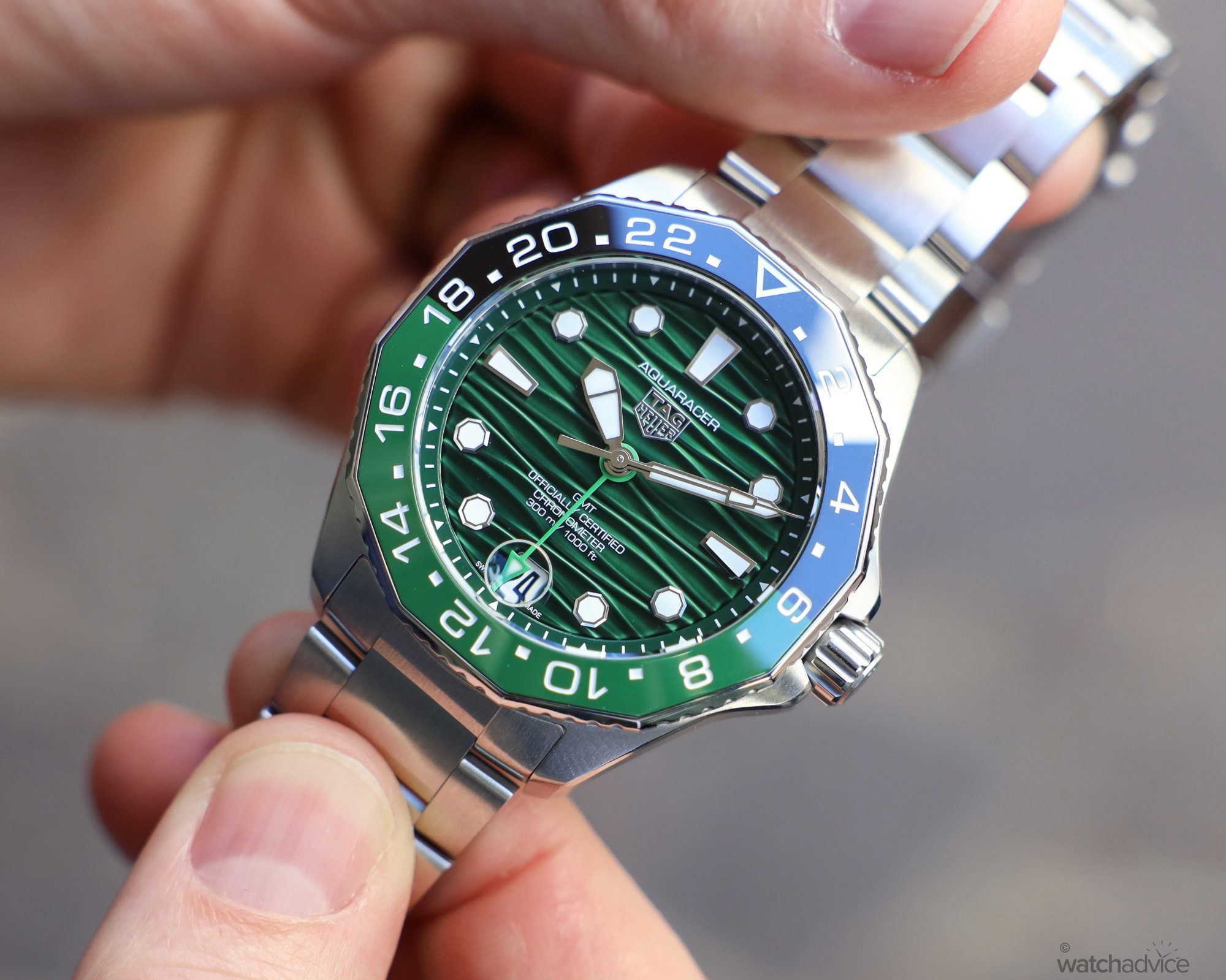
Across the 3D dial, TAG Heuer has Super-LumiNova filled hour markers in the shape of the now iconic Aquaracer bezel, which themselves seem to float above the dial surface, as does the TAG Heuer logo. TAG Heuer has kept the dial nice and symmetrical with the date window at 6 o’clock and over this, an inverted cyclops window. Unlike other brands whose cyclops window is on top of the crystal, TAG Heuer has put this under so it keeps the top of the domed crystal clean. Personally I feel that the Cyclops window could have been left off, and the date window increased in size slightly to match the hour indices to keep the balance. I’m nitpicking here though.
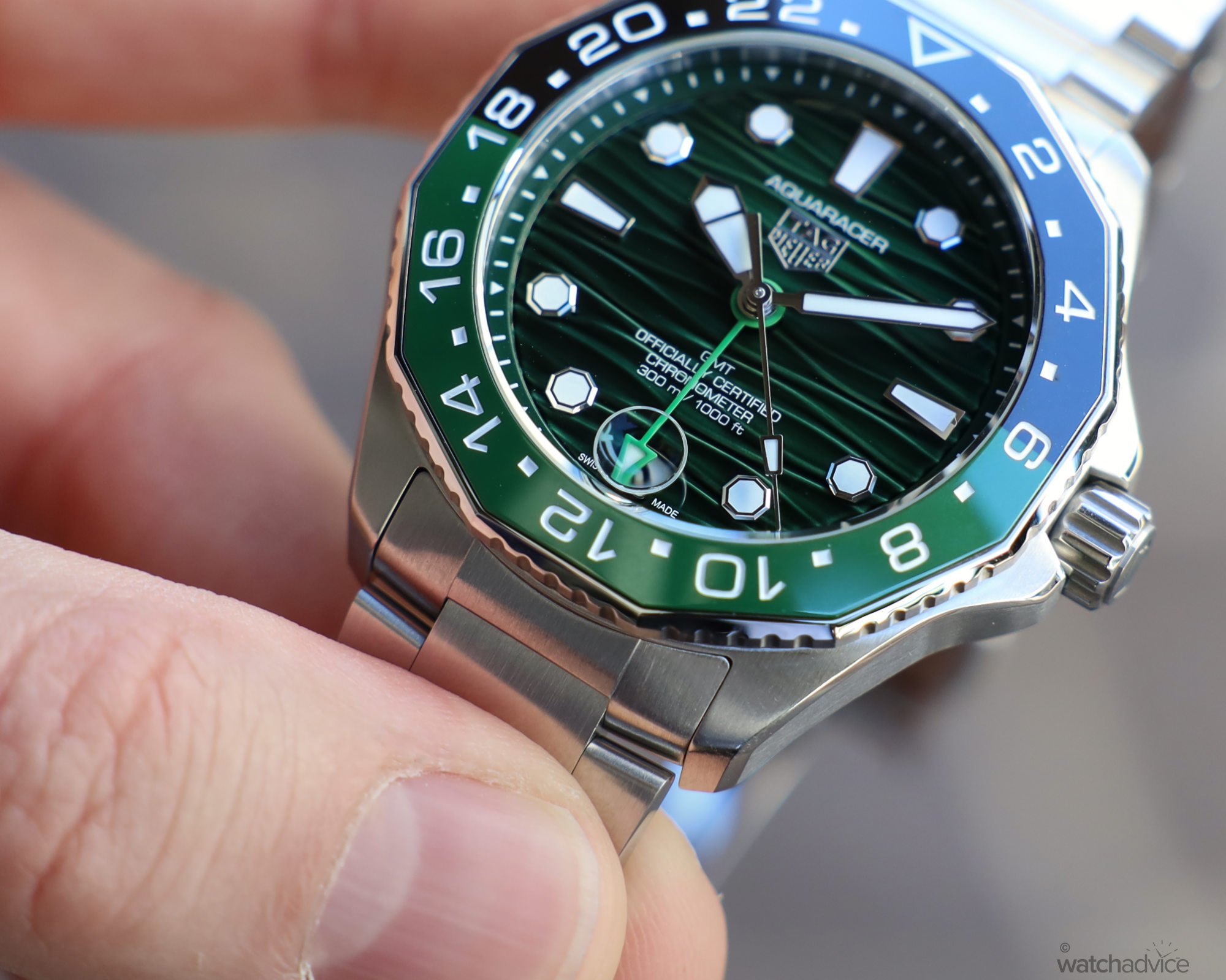
On this particular version, TAG Heuer has chosen the green and black combination for the bi-directional bezel. There is a blue and black variant as well (as seen in our Instagram feed below), both of which may remind you of another well-known GMT’s on the market. While some may try to draw direct comparisons to these other watches, I may remind you that there are only a certain number of colour combinations that you can really use for a GMT bezel without going crazy and way out of the box. Does anyone want to wear a pink and purple bezel GMT, perhaps a yellow and red bezel? I jest, but you get my point here.
On a serious note, the green that TAG Heuer has chosen is a great shade, being not too bright or too deep. the other thing to note is, the bezel is bi-directional to accommodate the GMT function. This means that this watch is technically not rated as a dive watch, but all other diver elements are there. Besides, 99.9% of people who have a dive style GMT won’t wear it diving, I know I never have!
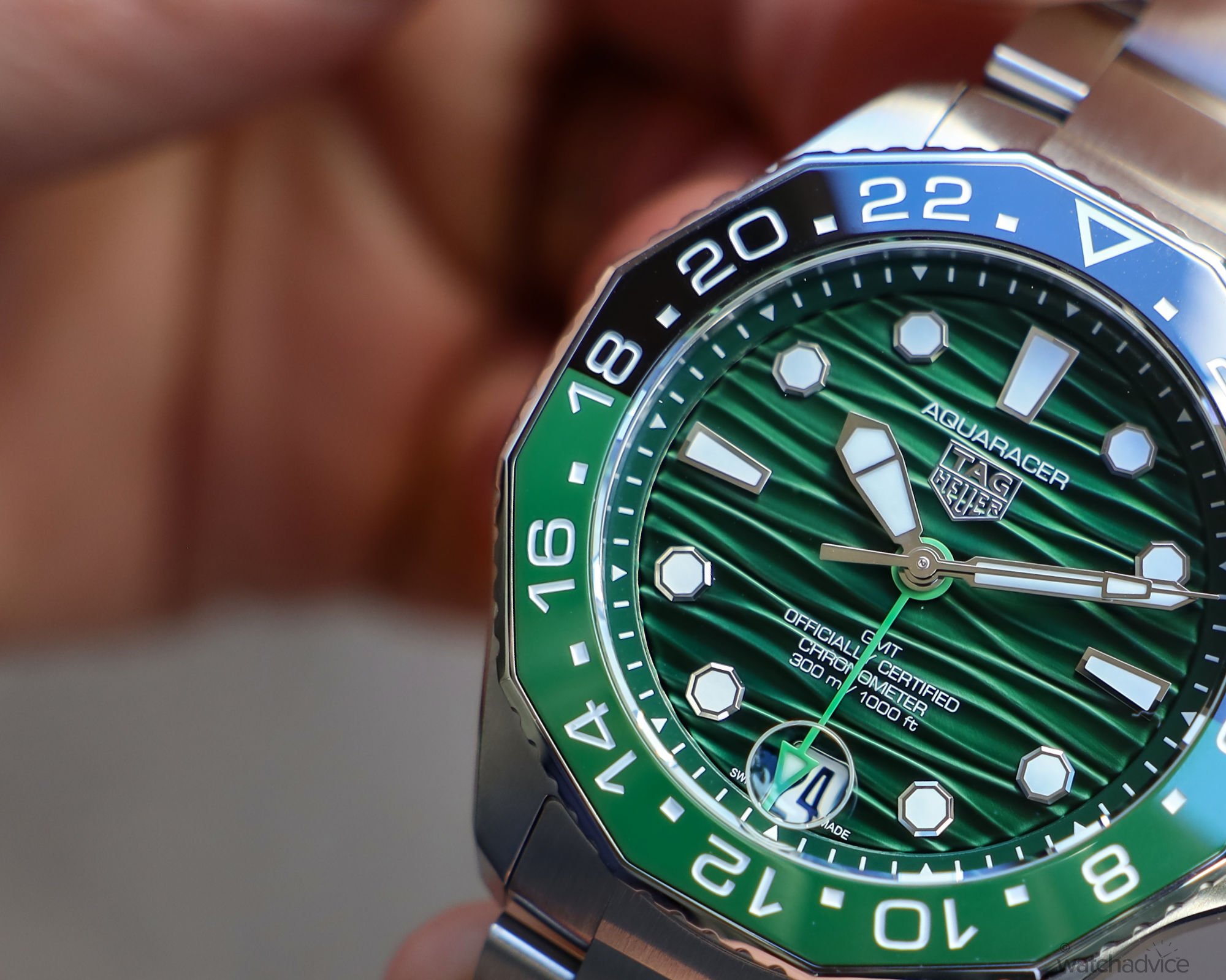
As mentioned, TAG Heuer has slimmed the new Aquaracer line down, which is the case with the GMT also. Moving from 43mm to 42mm, a shorter 48mm lug-to-lug it’s overall smaller than the previous models. The new variants are 12mm thick in the time/date models, and an additional 1mm for the GMT function, which is similar to the older model it replaced. I’ll cover more of these in the next section when looking at how the Aquareacer GMT wears. The other design element TAG Heuer has done well with is the on-the-fly micro-adjust in the clasp. I’ve said this is something that all brands need to do on sports watches. It makes sense as people’s wrists are not the same size all the time. Thankfully TAG Heuer has come to the party on this.
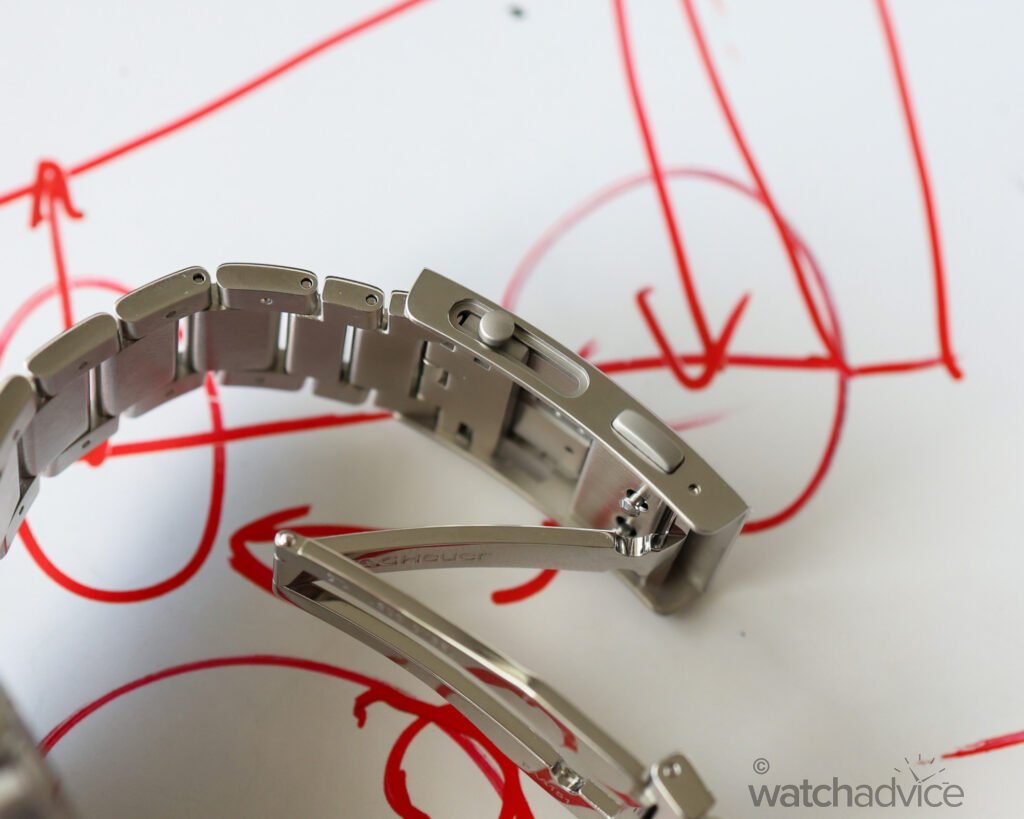
Sliding Micro-Adjust
The sliding micro-adjust means the wearer can adjust the Aquaracer GMT by up to approximately 1cm using the push buttons and doing so while on the wrist. A great feature and something that all sports watches on a steel bracelet should have.
On the case back, The Aquaracer displays the vintage divers helmet motif in positive relief, with the helmet’s window shaped in the dodecagonal style of the Aquaracer’s bezel. The case back is screwed in and raised slightly from the main case, which is done to accommodate the 300m water resistance, and as I’ll talk about shortly, also aids in the way the watch wears when on the wrist.
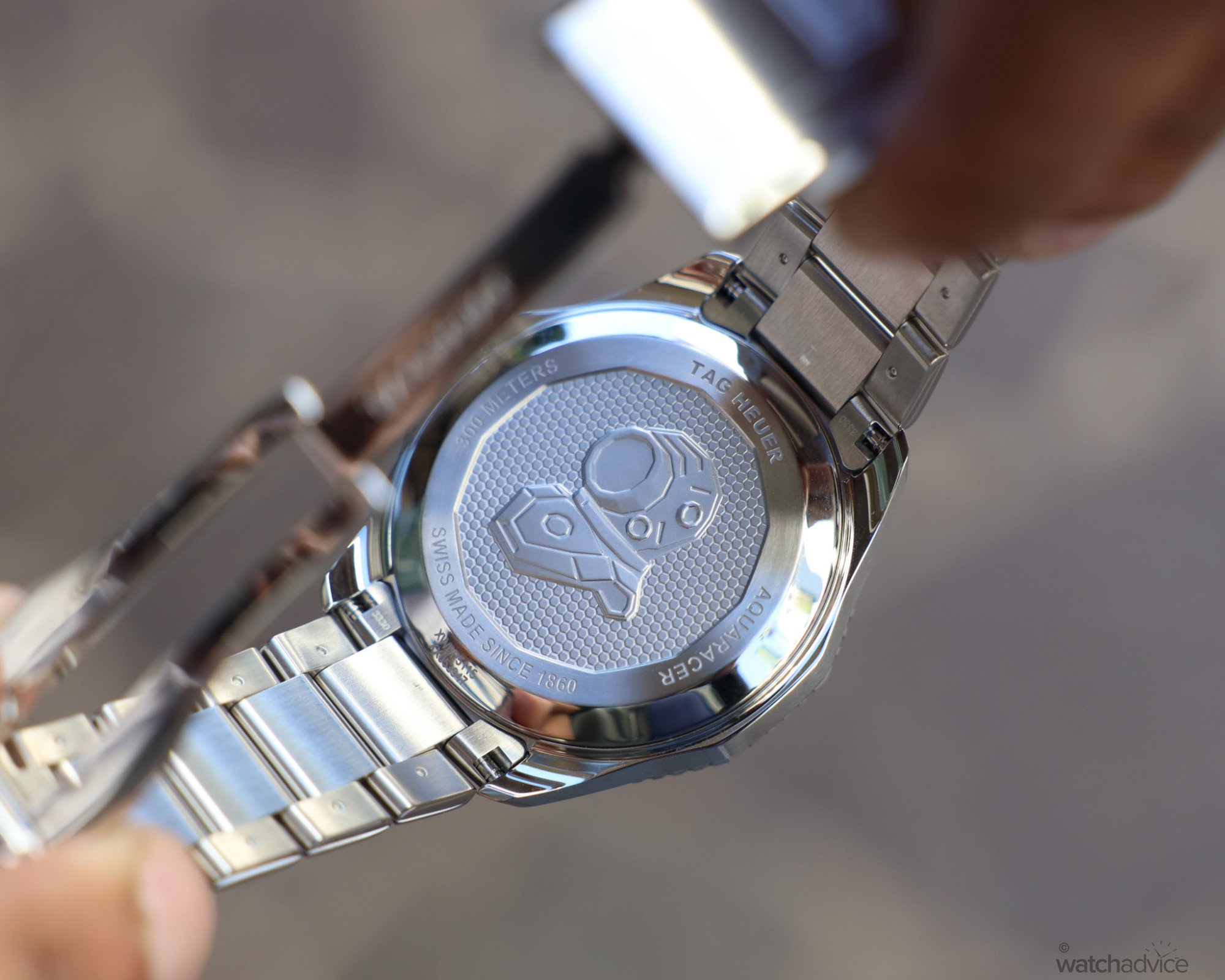
How It Wears
So first things first – the new Aquaracer is smaller than its predecessor having been shrunk both in diameter and lug to lug. While the official statement says this model has increased in thickness slightly, depending on how you measured the older variants, stays roughly the same around 12mm. Specifically talking about the GMT however, it is slightly thicker than its time/date siblings by 1mm, but this is hardly noticeable on the wrist. With all other proportions being equal, I feel the GMT still wears pretty much the same as the time/date variant. As I said in my opening talking about the design, the changes are small individually, but they all add up to a much better timepiece overall, and this can be said also of the wearing experience.
The 1mm difference in diameter makes a small difference in how the watch looks on the wrist, but the lug-to-lug at 48mm now is the biggest change in how the watch wears, with less apparent case to see across the wrist, it is now much better for those with average to smaller sized wrists. As a comparison, if you look at the two images below, and see it in the Instagram feed above, you can see how the Aquaracer GMT sits on different wrist sizes. I have a 17.5cm wrist, whereas Champs has a 16.5cm wrist. I have slightly more amount of real estate on my wrist, but not by much.
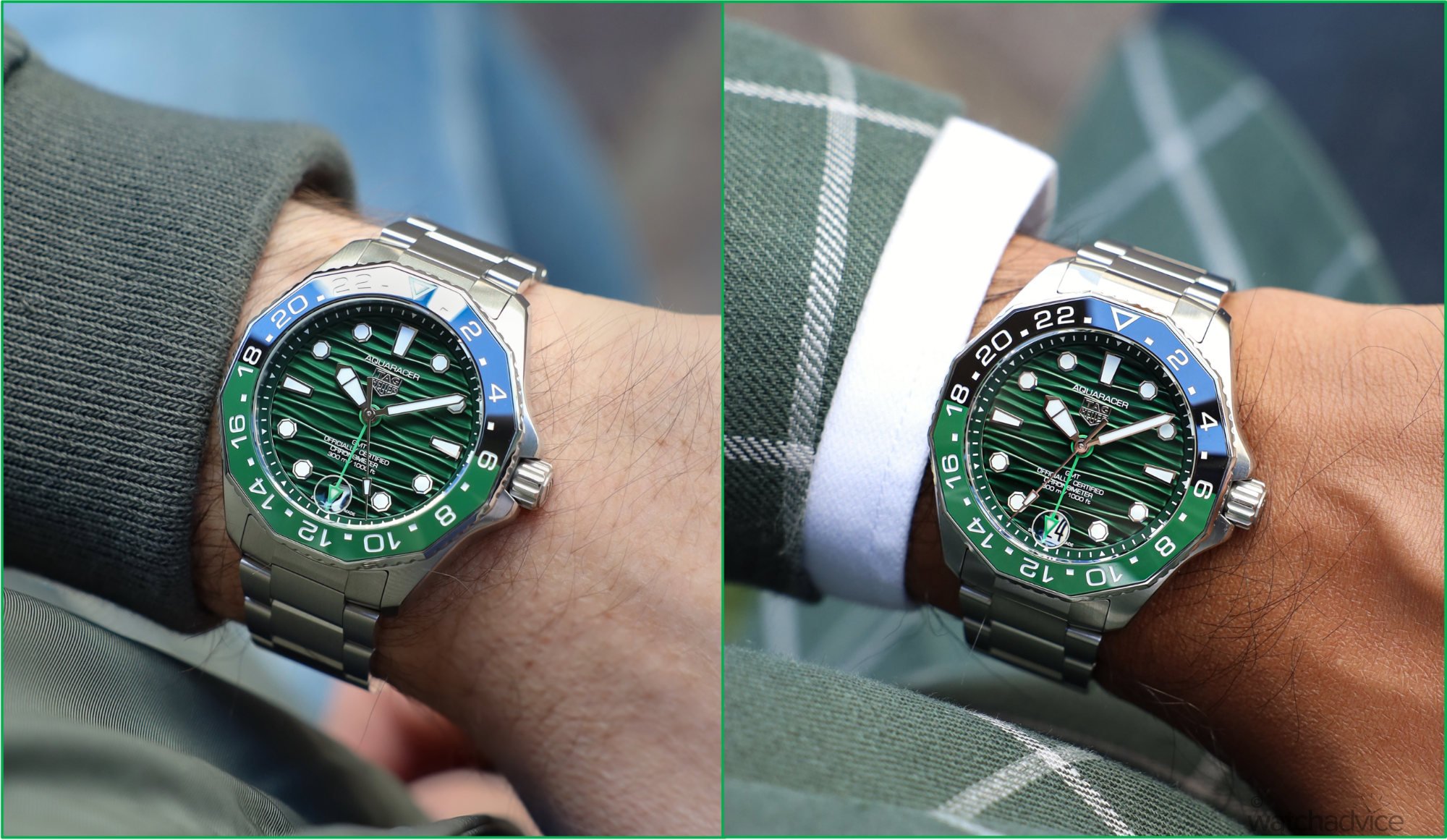
Personally speaking, any watch that is between 40-42mm in diameter seems to work relatively well on my wrist, and depending on the lug-to-lug and thickness, I can pull most watches in this range off. Again, this is a case of the way a watch is designed and the combination of the measurements as a whole – all make a difference to how it wears on someone’s wrist.
The other area that aids to the wearability of the Aquaracer is the way TAG Heuer has designed the case back to accommodate about 2mm of the case thickness which I touched on briefly in the last section. The case back is raised a little from the main case to assist in the 300m depth rating, but in doing this, part of the case’s thickness is essentially hidden in the wrist when wearing the watch. Whilst I like to think that this was done on purpose, it’s most probably a byproduct of the case’s design for the depth rating. Either way, it’s another small aspect that helps with the way the Aquaracer sits, feels, and looks on the wrist.
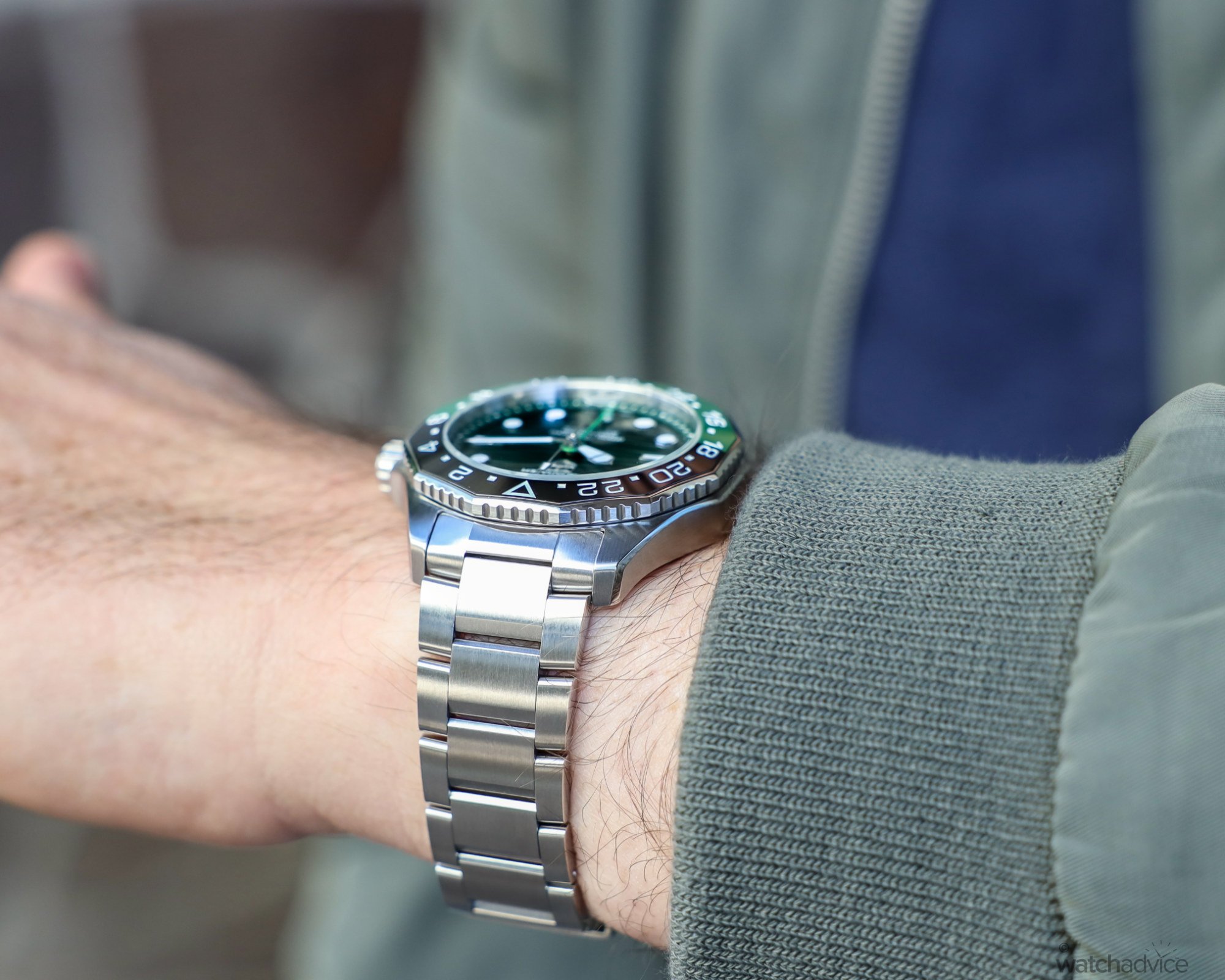
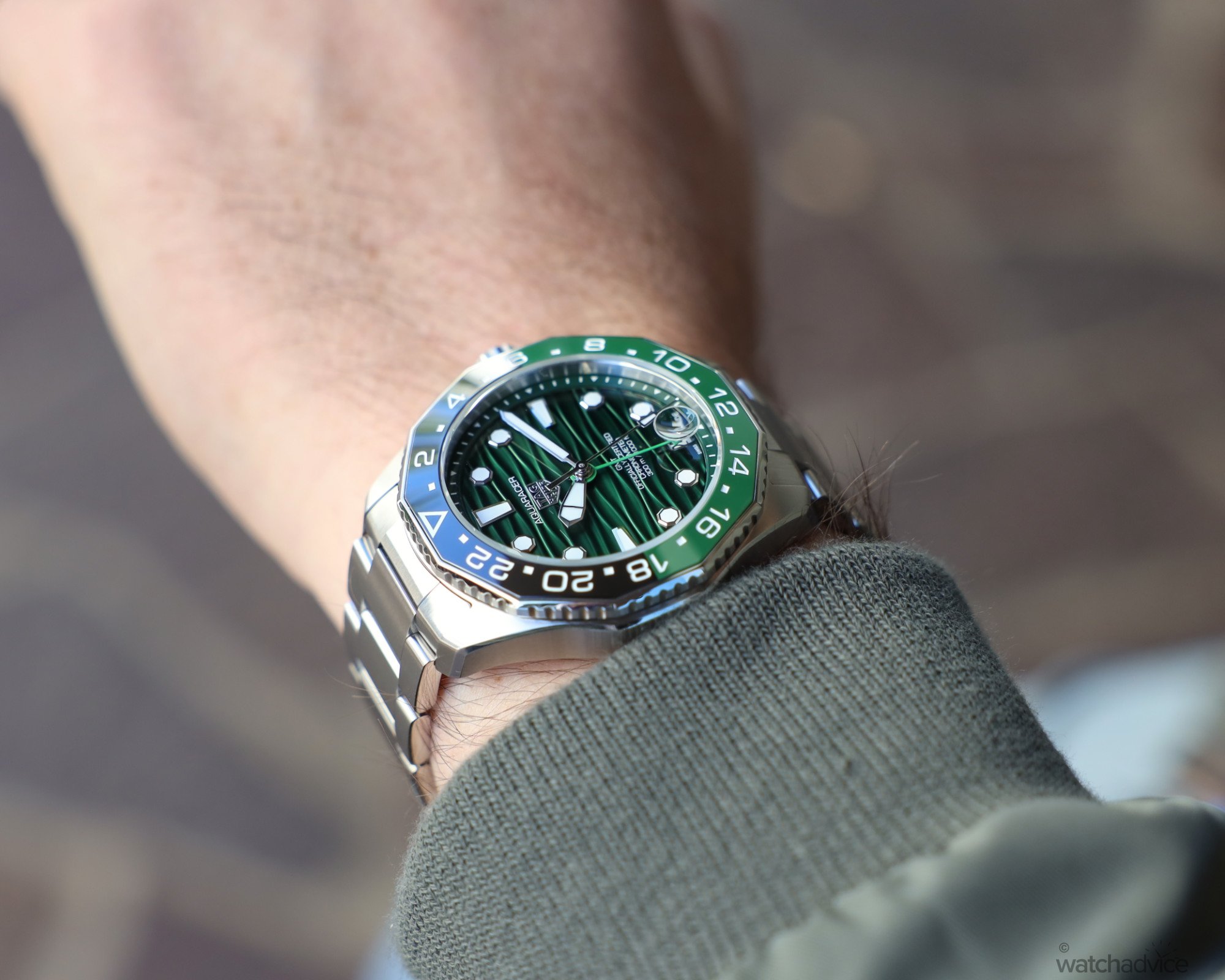
The sliding micro-adjust which was present on the old version has been kept here, which is welcomed, so thank you TAG Heuer. This helps on those warmer or cooler days when your wrist will expand or shrink, and if you have a wrist like mine, which does so regularly, then you know what I’m talking about here. Unlike other on-the-fly micro-adjusting clasps on the market, TAG Heuer has used push button on the side of the clasp, so you can essentially make those adjustments while you’re wearing the watch without having to take it off. In practice, I found that it was very easy to push the buttons and expand the clasp out, but if you want to slide it back in, then it’s a little harder thanks to gravity and friction. For me, it was just as easy to take it off quickly, slide it back in, and put it back on the wrist. If I compare this to say Tudor’s T-fit, Omega’s slider, or Rolex’s GlickLock system, then TAG Heuer’s push-button system here is probably a little better in terms of functionality and ease of use.
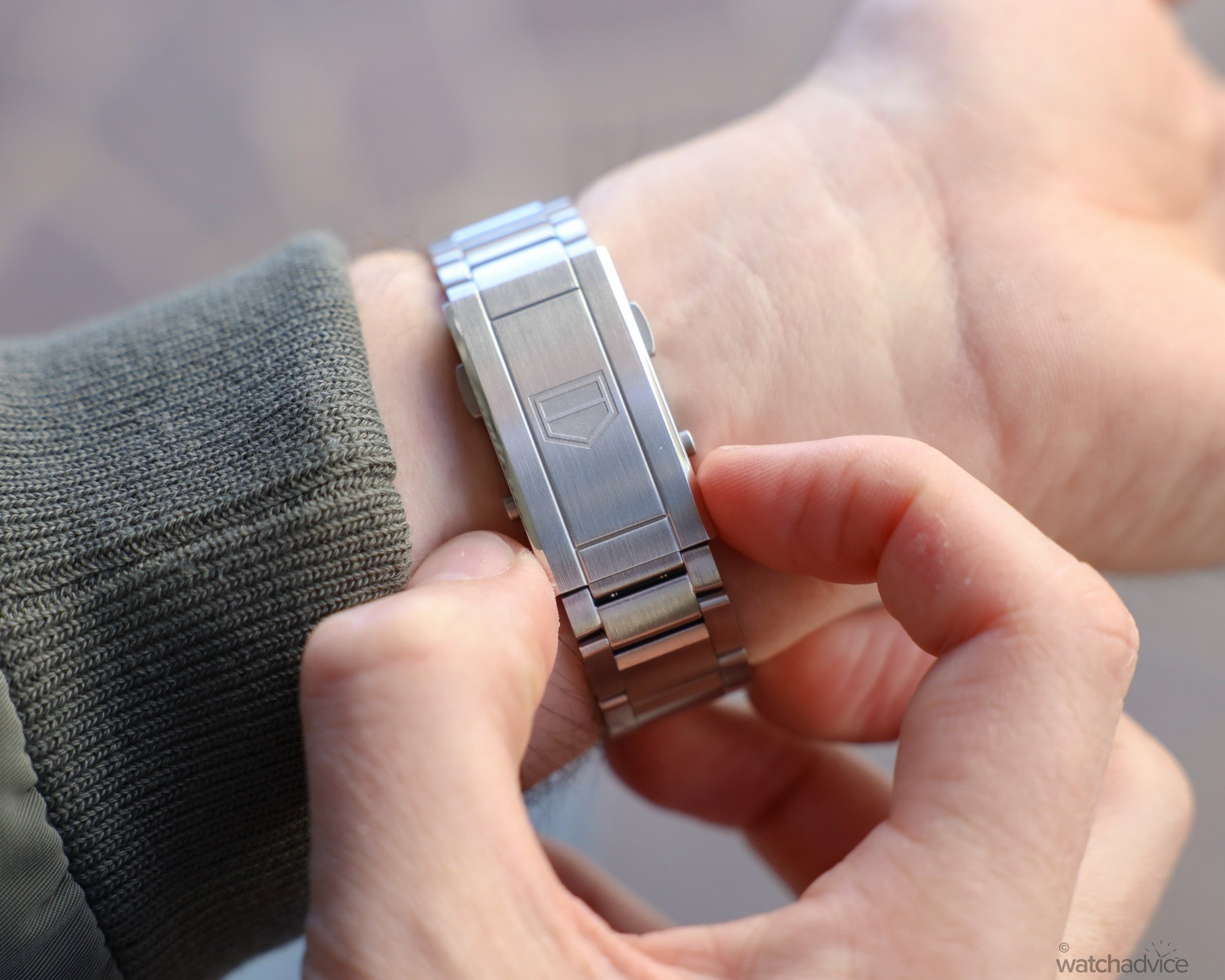
If I was being super picky, I’d love to see a slightly smaller clasp on the Aquaracer GMT. The length is probably just that little bit on the longer side, but this doesn’t really affect the way the watch wears. The clasp also felt less solid than I thought it would, but, again, this is me being picky and comparing to watches that are more than 3x the TAG Heuer Aqaracer’s price point. If you take this into account, then this is a nonissue.
The Movement
Gone is the old Calibre 5, TAG Heuer’s traditional automatic movement for the Aquaracer, and now inside the new Aquaracer GMT beats the TH31-03. Essentially this is the TH31-00 that is housed in the time/date versions with the added GMT functionality in the movement. The TH31-03 is a new, “in-house” movement developed by AMT for TAG Heuer specifically. The Calibre TH31-03 is COSC certified, so TAG Heuer now ensures its accuracy – another area that TAG Heuer is concentrating on, which was a key message TAG Heuer’s Movement Director, Carole Kasapi-Forestier impressed upon us whilst in Geneva in April. The other area where TAG Heuer has upped the ante with their movements is the introduction of an 80-hour power reserve. This is not unique to just the Aqaracers, all their in-house calibres for the Monaco and Carrera based on the Heuer 2 TH20 have this as well. Another indication that TAG Heuer is upping their game when it comes to movements.
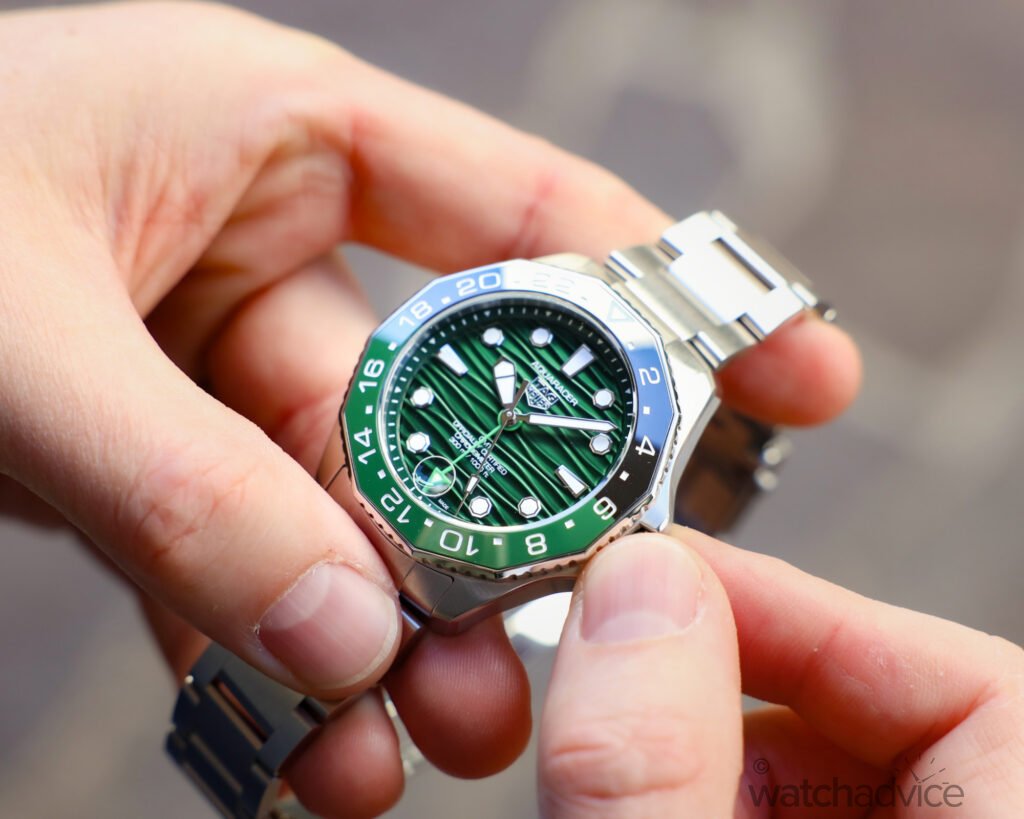
The TH31-03 has the added GMT functionality over the standard TH31-00. TAG Heuer has opted for a “Caller” style GMT here as opposed to a “Flyer” GMT. This means that the Aquaracer is designed more for people who want to track another time zone outside their home time, such as those who have relatives in another time zone, or workers on the other side of the country etc. If you’re looking to get this watch as a frequent flyer, then while you still can easily use the GMT, you will need to set it before jetting off as it doesn’t have the independent quick set hour hand. Personally speaking, I prefer the Flyer GMT over a Caller GMT as I use it when travelling, but again, it’s about your circumstances and how you intend to use the watch.
RELATED READING: Watch Education – Caller Versus Flyer GMT
While I’m talking about the GMT function, even though the bezel isn’t part of the movement, I feel that talking about the bezel action seems appropriate here. For this, I won’t use my words and experience as this is also where a little crowd-sourced “focus group” feedback comes in handy. At a recent Watch Advice event we held in conjunction with TAG Heuer in Brisbane, the Aquaracer GMTs were on show and with a range of watch enthusiasts, the first thing they do when they look at a dive bezel or GMT bezel is turn it. The feedback that we received on these was pretty unanimous – a great bezel action that’s both smooth and crisp. A 48-click GMT bezel has a slightly different feel to a 60 or 120-click dive bezel on many dive watches, which incidentally on the time only Aquaracers, also have a great action that is crisp and smooth, but nonetheless, seemed to impress the crowd who are sometimes not easily pleased!
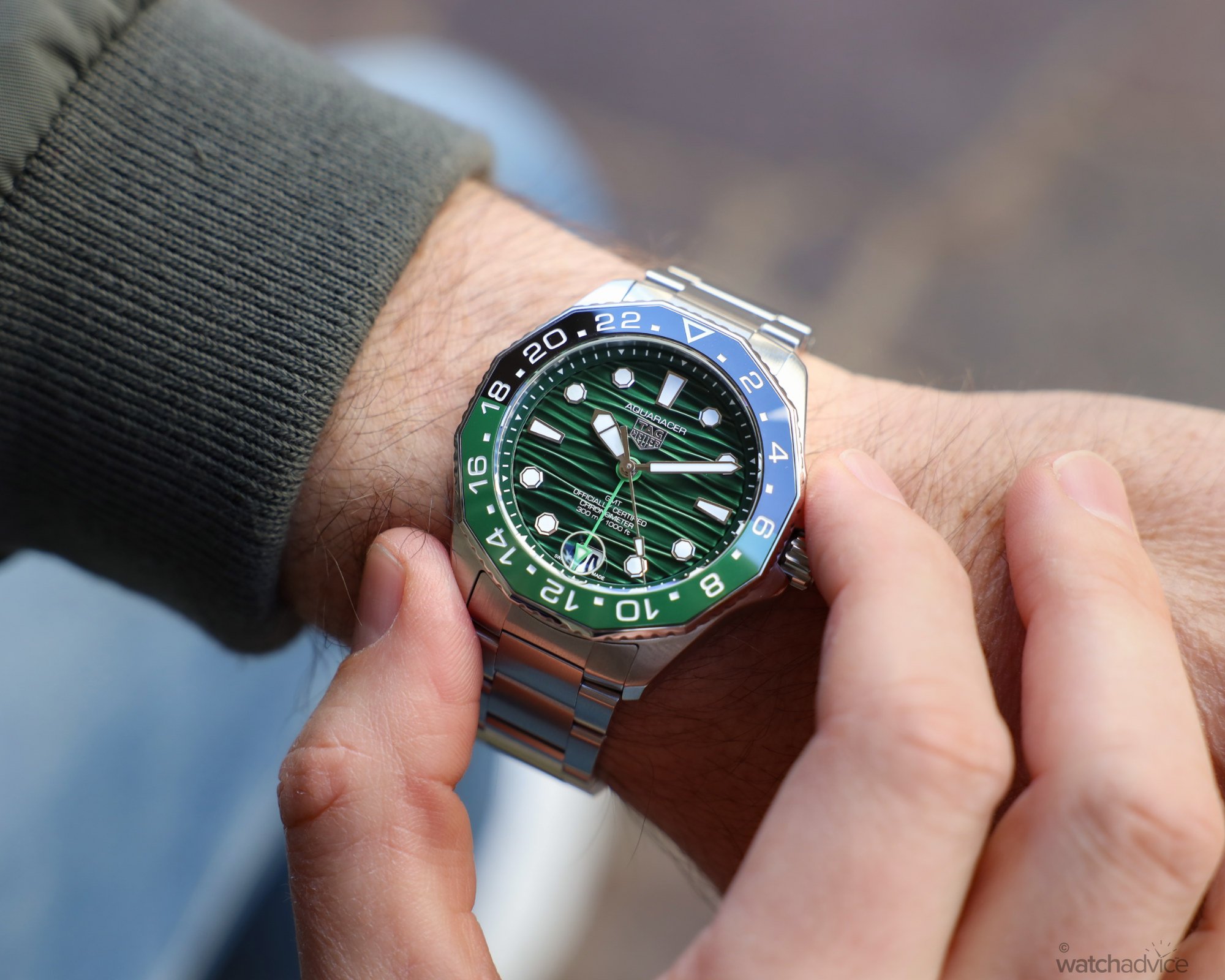
Final Thoughts
Having extensively played around with the new TAG Heuer Aquaracer GMT, not to mention the time/date models over the past few months, I can safely say that these are a great move from TAG Heuer, and one that seems to have got the nod of approval from many out there in the watch community. Rather than a small change here or there, or new colourways, TAG Heuer has re-thought this watch collection and said, “How can we make this a whole lot better?” Well, thankfully they thought of quite a few things, and this is indicative of where the brand is heading. TAG Heuer are taking a look back at their iconic pieces and designs, infusing this DNA with modern materials and slowly making improvements to them, with the movements being a key focus here.
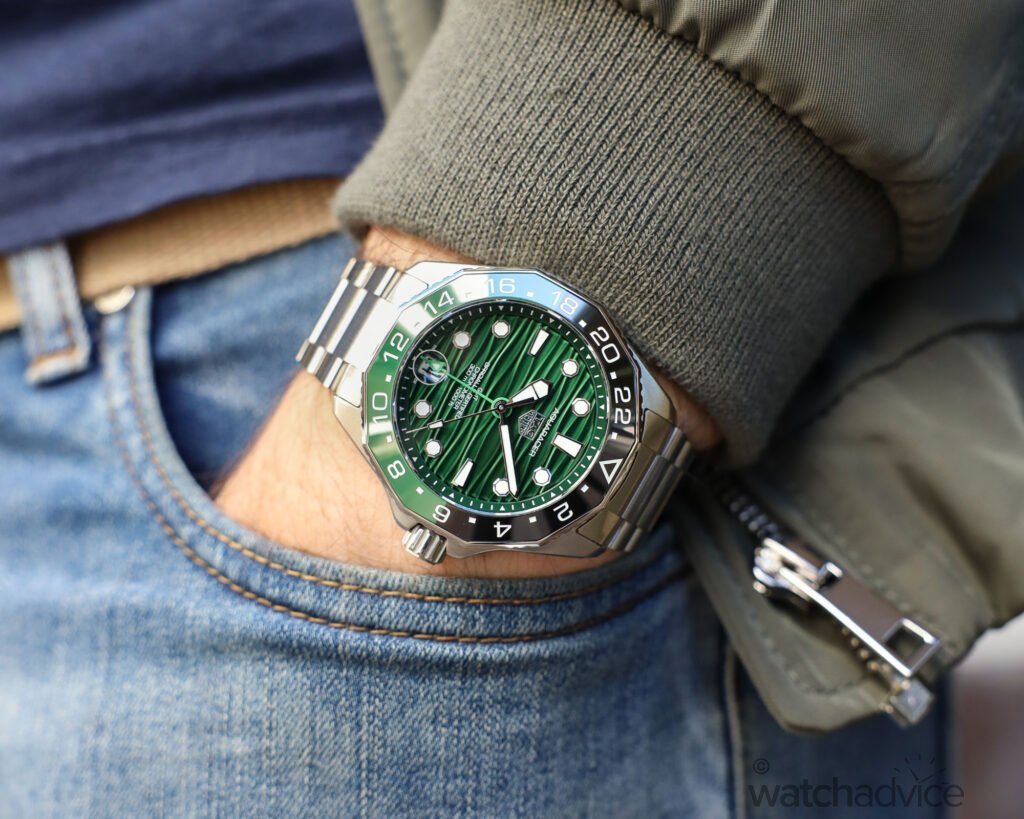
As an everyday watch, the Aquaracer GMT fits the bill. And if you’re not a fan of the green, then the blue variant should do the trick as it will possibly pair with more outfits or dress styles. Colour choice aside, the small design changes, aesthetics and improvements to the size, movement and clasp all add up to a watch that now wears differently from its predecessor and all in a good way. The price is the other thing to mention here. TAG Heuer has priced this piece pretty aggressively at A$6,100, which comparatively speaking, is very good indeed. (As an FYI, the blue version has a rubber strap alternative for A$5,800). You can see TAG Heuer taking aim at brands like Tudor, where their standard 41mm GMT on the bracelet is A$6,460, and while having those classic diver GMT looks from the late ’50s, hasn’t got some of the modern design cues of the Aquaracer, nor does it have the sliding micro-adjust on the clasp, a ceramic bezel and even though is 1.5mm thicker, has 100m less water resistance. However, the Tudor is a flyer GMT, vs the Aquaracer’s caller GMT – but both are relevant for different uses depending on the wearer. It seems that on paper, dollar for dollar, the Aquaracer GMT is punching above its weight here.
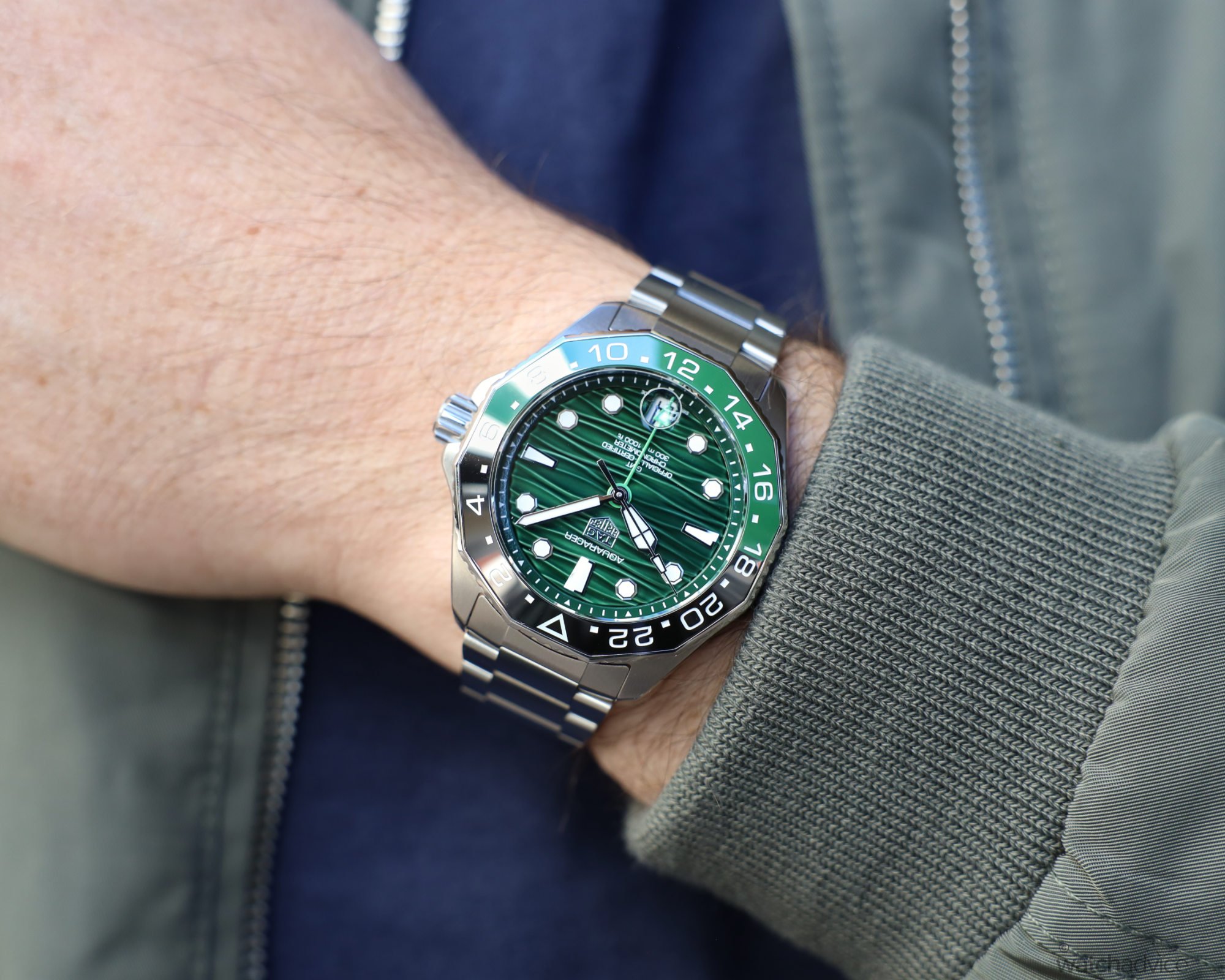
Overall, the new TAG Heuer Aquaracer GMT is a good everyday watch, that you can work and play in. It’s versatile enough to have on your wrist in the office and will look right at home doing any leisure activity. With the COSC movement, there are no worries relating to accuracy or reliability and being a diver, is super durable which is always a selling point. At A$6,100 it’s a great bang for buck watch that will be hard to go wrong with.
References:
- Black & Blue: WBP5111.BA0013 / Black & Green: WBP5115.BA0013
Specification:
- Size: 42mm, 13.1mm thick and 48mm lug-to-lug
- Case: Steel fine-brushed, polished case with ceramic 24-hour bidirectional, dodecagonal turning bezel
- Dial: Green 3D sunray brushed wave pattern
- Movement: Automatic mechanical in-house Calibre TH31-03, beating at 4Hz / 28,800 VpH
- Power reserve: 80hrs
- Water resistance: 30 bar (300 meters)
- Crystal: Flat sapphire crystal with double anti-reflective treatment
- Case back: Steel screwed case back with diver helmet relief
- Bracelet/Strap: Fine polished 3-link steel bracelet with steel folding clasp with double safety push-buttons with fine adjustment system.
Australian Recommended Retail Pricing: A$6,100 / A$5,800 on rubber (Blue only)
Availability: Available now from TAG Heuer boutiques, authorised dealers or online at TAGHeuer.com
Full Image Gallery
